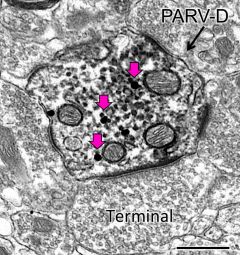Core Name: Neuroanatomy Electron Microscopy Core
Director: Teresa A. Milner, Ph.D.
Summary
The goal of the Core is to provide training and services in the processing of brain tissue for light and electron microscopic immunocytochemistry. Key aspects of the core include: 1) one-on-one training classes; 2) assistance with brain fixation and histology; 3) assistance with quantitative light microscopic immunocytochemistry on brain tissue; 4) assistance with quantitative single and dual labeling electron microscopic immunocytochemistry; 5) assistance with collection, analysis and interpretation of these preparations; and 6) assistance with preparing collected data for publication and meeting presentations.
Mission of the core
This Core primarily oversees experiments on brain tissue that utilize pre-embedding light and electron microscopic immunocytochemical methods.
Location
Feil Family Research Building, 407 East 61st St, 3rd floor
Service Performed by Core
- Providing consultation with experimental design and approach
- Performing and training in perfusion fixation procedures specific for brain EM immunocytochemistry
- Training in the sectioning of brains on a vibrating microtome (Vibratome).
- Long-term storage of brain sections in cryoprotectant in -20oC freezer.
- Assisting with characterizing and determining specificities of antibodies.
- Assisting with determining optimal antibody labeling conditions for immunoperoxidase and immunogold-silver methods.
- Training in quantitative light microscopic immunocytochemical methods.
- Training in dual labeling EM immunocytochemical methods.
- Assisting with embedding brain tissue in plastic.
- Cutting thin-sections on the ultratome.
- Training in cutting thin-sections on the ultratomes.
- Training in the use of the electron microscope.
- Training in identifying the types of neuronal and glial processes on the electron microscope.
- Training in the use of specialized MCID image analysis software for analyzing electron micrographs.
- Assistance with interpretation of data and statistics.
- Assistance with preparation of data for publication and presentations.
- Assistance with writing manuscripts.
Equipment Available in the Core
- Hitachi HT7800 Electron microscope
- 2 Leica Ultracut Ultramicrotomes
- Glass knife maker
- Loaner Diamond knives
- Oven for curing Epon plastic
- 3 Leica vibratomes
- 2 computers with MCID image analysis software
- Nikon light microscopes equipped with NIH image and digital cameras
- 2 -20oC ultralow freezers



